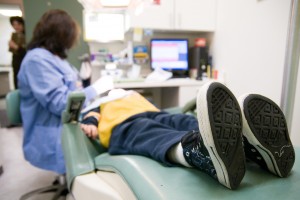A new report by health care consultant Barbara Aved does just that. Based on her research, Aved concludes that 25 percent of California’s general dentists participate in the program.
Why not more? Here are some of Aved’s primary conclusions, based in part on a survey of dentists in five counties that she says reflect California as a whole. Out of about 2,000 general and pediatric dentists invited to participate, 322 responded.
- Of dentists who do not participate, 97 percent cited the state’s low reimbursement rates as the No. 1 reason. California’s rates, Aved said, are among the lowest in the nation.
“Unlike physician practices, dental practices are in large part solo or two-person practices,” she said. “It’s really like a small business. Economically, it just doesn’t make sense to do business where you’re not going to be fully reimbursed.”
- Many dentists also blamed their non-participation on the bureaucratic requirements associated with enrolling and billing.
“Make the claim process simple and straightforward; quit denying claims for stupid, little reasons and obscure criteria,” wrote one dentist who responded to the survey.
“I would rather treat some people for nothing than jump through all the hoops Denti-Cal makes you go through,” wrote another.
- Some dentists complained about patients breaking appointments and other compliance issues.
Aved’s study, which also analyzed 2011 Denti-Cal claims data, was commissioned by dental plans LIBERTY Dental and HealthNet.
The Department of Health Care Services (DHCS), which administers Denti-Cal, has a very different take on the percentage of California dentists who participate: Two thirds of dentists, or 66 percent.
“What we’ve done with our numbers is take a look at verifiable data, data that was collected and that represents the actual figures that are kept by the state of California,” said spokesman Norman Williams. “It wasn’t a survey. … It’s actual data and that’s what we base our numbers on.”
But Aved pointed to a California HealthCare Foundation report on Denti-Cal from 2010 that also concluded that 25 percent of California dentists accept Medi-Cal patients.
Williams said current dentist participation in Denti-Cal already “ensures sufficient access,” but the department is taking several steps to boost participation. They include:
- Developing a survey for Denti-Cal beneficiaries to determine their satisfaction with the program;
- Offering a new customer service line to help children and their families locate participating dentists; and
- Reaching out to dentists to urge them to join the program or take more Denti-Cal patients.
The department is addressing complaints about bureaucratic obstacles by developing a webinar series, video tutorials and other materials for dentists to help them with enrollment and billing, Williams said.
But raising rates isn’t on the table.
“Because of our current economic situation, the state is not in a financial position to increase Medi-Cal payments to dentists,” Williams said.
Gayle Mathe, director of policy development for the California Dental Association, applauded the department for its recent moves to boost dentist ranks in the program. In many cases, she said, her association is partnering on these initiatives.
“We’re starting to see movement and changes in a positive direction,” she said. “And the department is really engaged in doing that.”
But the association questions the department’s conclusion that two-thirds of dentists participate Denti-Cal, saying that Aved’s figure is closer.
“We don’t have access to data, but the 25 percent is consistent with what we’ve heard anecdotally over the years,” Mathe said.
Aved said she’s concerned that not enough dentists participate as it is and worries that Denti-Cal isn’t prepared for the hundreds of thousands of new children coming into the program in the next few years. This will be primarily as a result of the transition of children from the publicly-funded Healthy Families program into Medi-Cal and the expansion of Medi-Cal under the Affordable Care Act.
“If it’s this way now, we should be worried about the future for sure,” she said.
